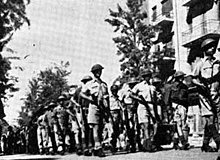
| 1948 Palestine war | |
|---|---|
| 1947–1948 civil war in Mandatory Palestine Military engagements
Massacres and civilian attacks
1948 Arab–Israeli War
Central and Jerusalem front
Northern front International Massacres Biological warfare |
From 13–18 May 1948 Jewish forces from the Haganah and Irgun executed Operation Pitchfork (mivtza kilshon). Its aim was to capture the Jewish suburbs of Jerusalem, particularly Talbiya in central Jerusalem.
Operation
At midnight on Friday 14 May, the British declared their civil and military authority in Jerusalem to be at an end. In the morning they evacuated the city in two large convoys, one moved north towards Haifa and the other south towards Bethlehem. The Zionists managed to obtain a schedule of their withdrawal in advance and could thereafter launch the operation almost immediately.

The Yishuv forces quickly managed to take control of buildings that the British had nationalized in "Bevingrad" zones. These were heavily fortified security zones that the British had built up around key installations in the city to protect against Irgun attacks. From 1946 to 1948, security zones with huge coils of barbed wire filling the streets and dragon's teeth blocking the incursion of armed vehicles began appearing around Jerusalem. One such zone, established in 1946, encompassed the eastern end of Jaffa Road and included the Russian Compound, the Anglo-Palestine Bank, the Central Post Office, and the Generali Building. Jerusalemites called these fortified zones "Bevingrad", a portmanteau of the name of the British Foreign Secretary Ernest Bevin, who had denied Holocaust survivors entry to Palestine, and the Russian city of Stalingrad, where large-scale fortifications had been emplaced prior to the 1942 Battle of Stalingrad.
On Friday, 14 May 1948, the Irgun forces headed for the Bevingrad on Jaffa Road. The first building they captured was the Generali Building, now evacuated. The Irgun forces hoisted the Israeli flag over the lion statue on the roof before moving on to take control of the Russian Compound and the Police Academy further north.
They also captured the Notre Dame Church, the American Colony, Sheikh Jarrah, Talbiya, German Colony, Baka, Talpiot, and the Greek Colony.
A large portion of what was captured was to become the Israeli-controlled portion of Jerusalem—"West Jerusalem"—but some of the heaviest battles of the 1948 Arab-Israeli war were to follow and the Jerusalem frontier was to be redrawn many times.
See also
- 1947–48 Civil War in Mandatory Palestine
- List of battles and operations in the 1948 Palestine war
- Depopulated Palestinian locations in Israel
References
- "Emerging City". The Jerusalem Post. 18 May 2001. p. 10. Archived from the original on 11 June 2014. Retrieved 3 April 2014.
- ^ Bar-Am, Aviva (19 September 2003). "Return to Bevingrad". The Jerusalem Post. Archived from the original on 11 June 2014. Retrieved 3 April 2014. (subscription)
- ^ Rosenne, Shabtai. "The United Nations and Israel's War of Independence", in An International Law Miscellany. 1993: Martinus Nijhoff Publishers, p. 646. ISBN 0792317424.
- Jewish Agency for Israel (1949). The Jewish Agency's Digest of Press and Events, Vol. 2, p. 61.
- Neiman, Rachel (28 July 2013). "AKA Bevingrad – The new Shlomzion Square". Israel21c. Retrieved 3 April 2014.
- Even-Or, Shmuel (May 1984). ירושלים: בניינים בעיר החדשה [Jerusalem: Buildings in the New City]. Kardom (in Hebrew): 20–23.
- Lapidot, Professor Yehuda. "The Jerusalem Battalion". etzel.org.il. Archived from the original on 9 January 2022. Retrieved 3 April 2014.
External links
- Etzel (Irgun) history Archived 9 January 2022 at the Wayback Machine
Photos
- Bevingrad surrounded by barbed wire on the left Archived 20 July 2002 at the Wayback Machine
| Israeli military operations in the 1948 Arab–Israeli War | |
|---|---|
| Pre-IDF | |
| IDF | |
31°46′51.49″N 35°13′24.44″E / 31.7809694°N 35.2234556°E / 31.7809694; 35.2234556
Categories: